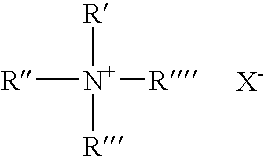Process and composition for cleaning medical instruments
- Summary
- Abstract
- Description
- Claims
- Application Information
AI Technical Summary
Benefits of technology
Problems solved by technology
Method used
Image
Examples
example 1
[0047]
g / lBenzyl dimethyl ammonium chloride, CAS 68424-85-1150Sodium tetraborate decahydrate, CAS 12007-42-030Glycerin, CAS 56-81-525Terric GN9 (note1)200Dipropylene Glycol Methyl Ether CAS 34590-94-8100Water balance to1000Note 1:Terric GN9 is ethoxylated nonylphenol available from ORICA and is a non-ionic surfactant.
Preparation
[0048]The sodium tetraborate is dissolved / suspended in the glycerol at 80° C. The quaternary biocide and Terric GN9 (non-ionic detergent) are combined with the DPM and the pH adjusted with e.g. acetic acid to pH 7.2–7.3. The borate / glycerin solution is then combined with the quaternary biocide
example 2
[0049]Example 2 is identical to example 1 but includes 0.1% of subtilisin (0.1% protease enzyme).
[0050]Table 1 shows MIC results obtained with various combinations of components of example 1 and example 2 in the absence of the boron and, in accordance with the invention, in the presence off the boron. In Table 1 “Quat” is an abbreviation for benzyl dimethyl ammonium chloride
[0051]
TABLE 1MIC, ppmMIC, ppmcomposition(no boron)(with boron)A1. quat (prior art)20122 quat + DPM1683 quat + GN92584 quat + DPM + GN916B1 quat + subtilisin (0.1% protease enzyme)50252 quat + DPM + enzyme25123 quat + GN9 + enzyme25124 quat + dpm + GN9 + enzyme258
[0052]Table 1 part A compares the MIC of various quaternary ammonium biocidal compositions in the absence of boron and in the presence of boron but in the absence of protein. MIC was measured by test method described in Bailey and Scott Diagnostic Microbiology, 8th edition, 1990, p.177 using one of the most resistant to QUATs strains of Pseudomonas aerogi...
example 3
[0057]
Component% w / wA.Nonyl phenol ethoxylate (Terric GN9)3Di (propylene glycol) methyl ether5Perfume.1Water15B.Sodium tetraborate decahydrate6Glycerol4water5C.Acetic acid to pH 7.2–7.3D.Ethylene Glycol5(10% subtilisin) Alcalase 2.5 DL3E.Benzalkonium Chloride 80%30Waterto 100
[0058]Premix Borax with hot water and glycerin, add to A, adjust pH, let the mixture cool down 30° C. and then slowly add premixed ingredients D. Then add water premixed with Benzalkonium Chloride 80%.
[0059]The composition is stable for at least 1 year prior to use when stored in a sealed container at 18–25° C. and when diluted with water 200:1 is biocidally effective in use for at least 24 hrs. achieving “Hospital GRADE A” disinfection.
[0060]The composition is also biocidally effective at dilutions of less than 200:1, for example, 20:1.
PUM
 Login to View More
Login to View More Abstract
Description
Claims
Application Information
 Login to View More
Login to View More - R&D
- Intellectual Property
- Life Sciences
- Materials
- Tech Scout
- Unparalleled Data Quality
- Higher Quality Content
- 60% Fewer Hallucinations
Browse by: Latest US Patents, China's latest patents, Technical Efficacy Thesaurus, Application Domain, Technology Topic, Popular Technical Reports.
© 2025 PatSnap. All rights reserved.Legal|Privacy policy|Modern Slavery Act Transparency Statement|Sitemap|About US| Contact US: help@patsnap.com


